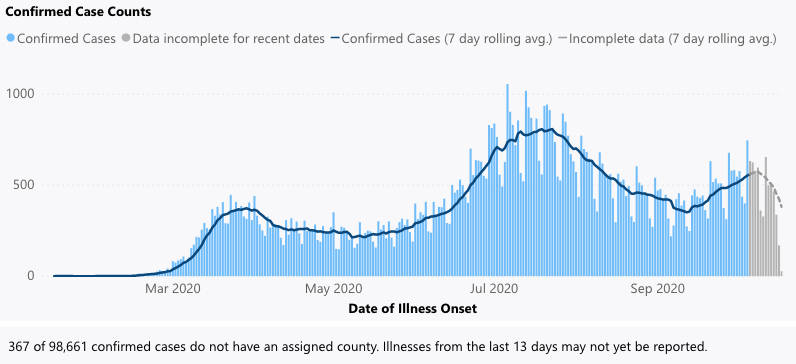Submitted by the Washington State Department of Health
Data from the Washington State Department of Health, https://www.doh.wa.gov/Emergencies/COVID19/DataDashboard, shows that case numbers in western Washington counties are climbing at an alarming rate, near or beyond previous peaks in some areas. As cases in King, Pierce, and Snohomish counties continue to trend sharply upward, health officials warn we may now be entering the fall surge.
This is not a problem we’re facing on our own. Nationwide, numbers are concerning as well. On Oct. 16, there were 70,000 cases in one day in the United States, matching the largest number set back when disease activity was high in July. These cases are climbing, not because of localized outbreaks, but because of widespread disease transmission. A surge in cases right now could have very serious consequences for our healthcare system, local plans to open schools, the state’s economic recovery, and beyond.
“When this happens, we place everyone, but particularly our elders, parents, grandparents and those with diabetes, heart disease, cancer and other chronic diseases at great risk. A surge in COVID-19 along with flu season puts us at enormous risk of overwhelming our hospital systems and undoing other important statewide progress toward containment,” Secretary of Health John Wiesman said. “However, all of us doing our part can turn this trend around.”
There is so much happening right now that make our efforts challenging. People have been at this for months, online schooling is pulling attention of people with children at home, and everyone is feeling some level of isolation fatigue. Now is the time to join your neighbors and commit to key behaviors that keep the virus from spreading, like:
• Wearing a mask, even with people you see regularly and in your smallest social circles and anytime you are using shared transportation, including while in your own vehicle with other people.
• Keeping gatherings small and hold them outside whenever possible.
• Avoiding any social gatherings indoors, but if you must participate, wearing a mask and ensuring windows and doors are open to maximize ventilation.
• Washing or sanitizing hands often and not touching your face.
• Staying home if you’re sick or if you’ve been exposed to COVID-19.
“It’s time to flatten the curve again,” State Health Officer Dr. Kathy Lofy said. “I’m optimistic we can get our kids in school, keep our businesses open, and control the spread of COVID-19 if everyone does their part.”




